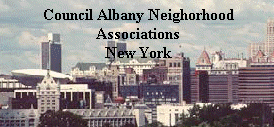
|
|
|
|
Putting the Comprehensive Plan to Work Patricia E. Salkin Associate Dean and Director Government Law Center of Albany Law School
"Among the most important powers and duties granted by the legislature to a city government is the authority and responsibility to undertake city comprehensive planning and to regulate land use for the purpose of protecting the public health, safety and general welfare of its citizens." What is a Plan? What is a land use plan? What is a land use plan used for? What is the difference between a master plan and comprehensive plan? How long should a plan last? Can a plan be updated?
A land use plan proposes the future distribution, location, and variety of structures (or open space) in the neighborhood. Land uses include residential, retail, office, industry, open space, and recreation space. The land use plan often serves as a tool for preserving and strengthening a neighborhood. It can also offer strategies for revitalizing a neighborhood in decline or, when appropriate, provide direction for building in a largely undeveloped area. Comprehensive Plans in the Region - Examples 2001 Town of Guilderland 2004 Town of New Scotland 2005 Town of Bethlehem 2005 Town of Colonie 2005 City of Troy 2006 City of Schenectady Town of Coeymans – started 2005 State Law Defines Comprehensive Plan "city comprehensive plan" means the materials, written and/or graphic, including but not limited to studies, resolutions, reports and other descriptive material that identify the goals, objectives, principles, guidelines, policies, standards, devices and instruments for the immediate and long-range protection, enhancement, growth and development of the city." Gen. City Law 28-a(3) Zoning Must be Consistent with a "Well Considered" Plan What does it mean to be "consistent with the comprehensive plan"? What happens if zoning is not consistent with a plan? What Should a Comprehensive Plan Contain? Goals, objectives, principles, policies and standards Consideration of regional needs and the official plans of other governmental units and agencies within the region Existing and proposed local and intensity of land uses Consideration of agricultural uses, historic and cultural resources, coastal and natural resources and sensitive environmental areas Population, demographic and socioeconomic trends and future projections Location and types of transportation facilities More Comp. Plan Elements Existing housing resources and future housing needs, including affordable housing Present and future general location of education and cultural facilities, historic sites, health facilities and facilities for emergency services Existing and proposed recreation facilities and parkland Present and potential future general location of commercial and industrial facilities Specific policies and strategies for improving the economy in coordination with other plan topics Measurements to implement the goals & objectives More plan elements All or part of the plan of another public agency Any and all other items consistent with the orderly growth and development of the city Developing a Comprehensive Plan City council, planning board or special board Only city council can adopt the plan Citizen Input Public hearings and other such meetings to assure full opportunity for citizen input At least two meetings legally…practically, many more are essential Effect of a Comprehensive Plan "All city land use regulations must be in accordance with a comprehensive plan adopted pursuant to this section." "All plans for capital projects of another governmental agency on land included in the city comprehensive plan adopted pursuant to this section shall take such plan into consideration." Gen. City Law 28-a is not binding "It is the intent of the legislature to encourage, but not to require, the preparation and adoption of a comprehensive plan pursuant to this section. Nothing herein shall be deemed to affect the status or validity of existing mater plans, comprehensive plans, or land use plans." Gen. City Law 28-1(2)(h) Neighborhood Planning is Part of Comprehensive Planning "The participation of citizens in an open, responsible and flexible planning process is essential to designing the optimum city comprehensive plan." |